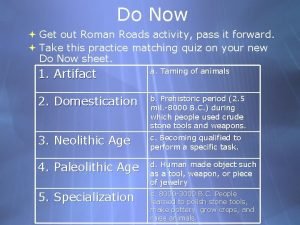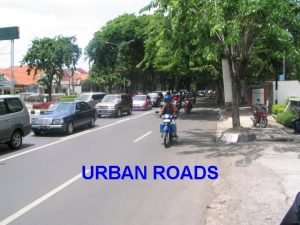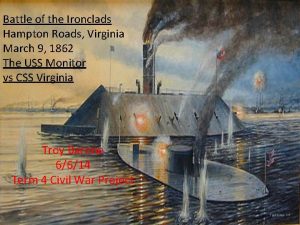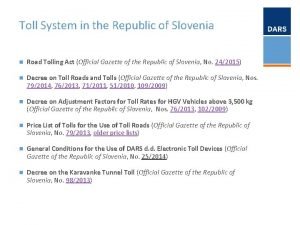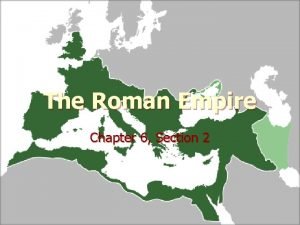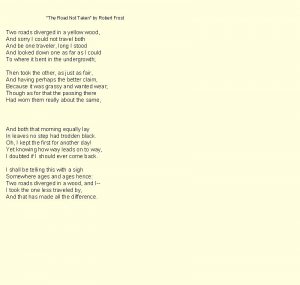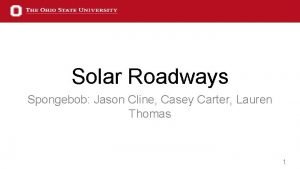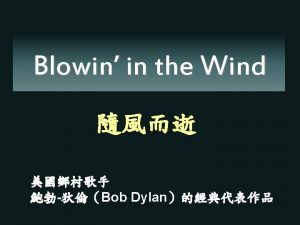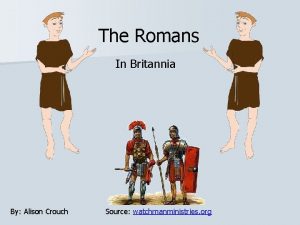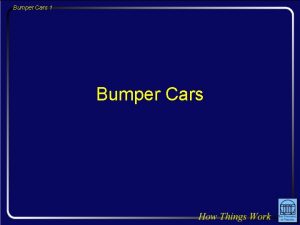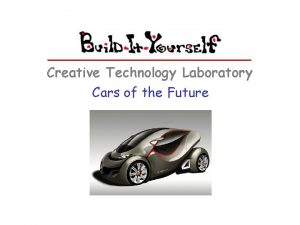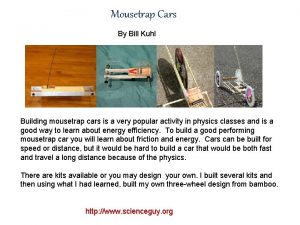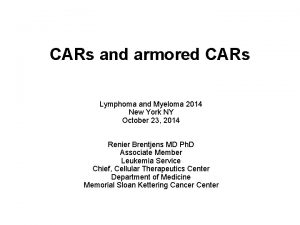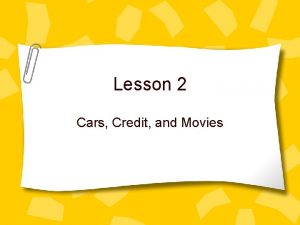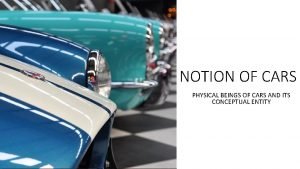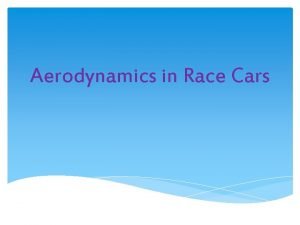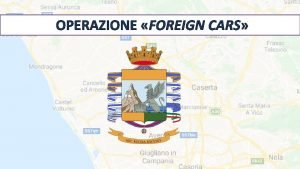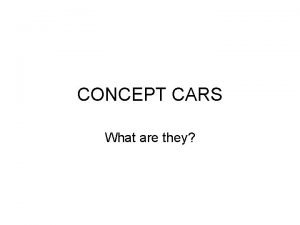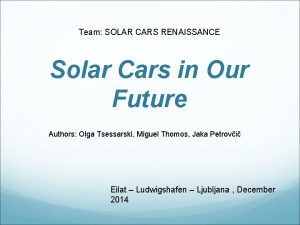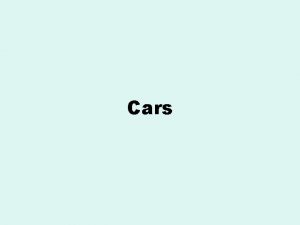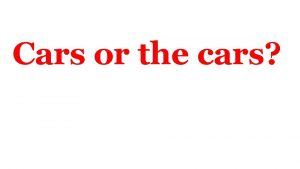ENERGY ENERGY Energy moves cars along the roads





















- Slides: 21

ENERGY

ENERGY • Energy moves cars along the roads and makes aeroplanes fly. • It plays our music on the radio, heats our rooms and lights our homes. • Energy is needed for our bodies, together with plants to grow and move about.

ENERGY IS OUR EVERYDAY LIFE

• It makes things happen. It makes change possible. Scientists define ENERGY as the ability to do work. Energy can be neither created nor destroyed.

Conservation of Energy: “ Energy can neither be created nor destroyed but may be transformed from one form to another” This means that total energy within a system is constant unless external work is supplied to the system or taken from it

• Early in the 20 th century, Einstein figured out that even mass is a form of energy (this is called mass-energy equivalence). The amount of mass directly relates to the amount of energy, as determined by the most famous formula in physics: • E=mc² (which states that mass and energy are one and the same) • • E is the amount of energy in an object or system. m is the mass of the object or system. c is the speed of light, roughly 3× 108 m/s. This equation is only representative of an object at rest, so this energy is called the "rest energy" of an object.

KINDS OF ENERGY • Energy Exist in many forms: ü Mechanical Energy ü Sound Energy ü Chemical Energy ü Heat Energy ü Electrical Energy ü Atomic Energy

Mechanical Energy • Mechanical energy is the sum of kinetic and potential energy in an object that is used to do work. • In other words, it is energy in an object due to its motion or position, or both.

Mechanical Energy: Exist in 3 forms: 1. Potential Energy (gravitational potential energy) 2. Kinetic Energy 3. Strain Energy (elastic energy) 1. Potential Energy (PE) - energy possessed by the a body because of its position relative to a fixed point or datum. PE = mgh Given: ü m = mass(kg) ü g = acceleration due t gravity in (m/sec) ü h = vertical height (m)

2. Kinetic Energy(KE) – energy possessed by a body because of its motion. All moving things have kinetic energy. Units is joules. KE = ½ mv² Given: ü m = mass (kg) ü v = velocity (m/sec) 3. Strain Energy – energy existing within a compressed spring or a material deformed within its elastic limit. This also means that elastic potential energy is zero in objects that have not been stretched or compressed.

Kinetic Energy in use. A hydro-electric power dam uses the concept of kinetic energy in fast flowing water to produce electricity.

1. Water from a stream or river is held up (blocked) by the sluice gate. Holding up more water increases potential energy and gravitational energy. 2. The gates are then opened. Water rushes down through the gate and into the tubes. There is immense kinetic energy in the very fast flowing water because of the high pressure it has. 3. Kinetic energy in the fast flowing water turns shafts (blades) connected to the end of the tubes. More fast flowing water means more blades can be turned even faster. 4. The spinning blades or shafts are connected to a generator which generates the electricity. The generator is connected to a transformer which supplies our homes with electricity.

Sound energy Sound is the movement of energy through substances in longitudinal (compression/rarefaction) waves. Sound is produced when a force causes an object or substance to vibrate — the energy is transferred through the substance in a wave. I = P/A

Heat (Thermal energy) • Thermal energy is what we call energy that comes from the temperature of matter. • The hotter the substance, the more its molecules vibrate, and therefore the higher its thermal energy. • Q = mc∆T

Chemical energy • Chemical Energy is released when bonds form in a chemical reaction, often producing heat as a by-product (exothermic reaction). • Batteries, biomass, petroleum, natural gas, and coal are examples of stored chemical energy.

Electrical energy • Matter is made up of atoms. In these atoms, there are some even small stuff called electrons that are constantly moving. The movement of these electrons depends on how much energy it has. • There are special mediums (materials) called conductors, that carry this energy. • We generate electrical energy when we succeed in causing these electrons to move from one atom to the other, with the use of magnetic forces.

Example: A steel ball bearing of mass 50 grams is dropped from a height of 2 meters on to a smooth, flat, rigid steel plate and rebounds to a height of 1. 75 meters. Calculate: a. b. c. d. Its original potential energy. Its kinetic energy the instant before it hits. Its kinetic energy the instant it starts to rebound. The velocity upon impact.

Solution: a. Its original potential energy. PE = mgh Given: ü m = 50 g / 1000 g/kg = 0. 05 kg ü g = 9. 81 üh=2 m PE (j) = 0. 05 (kg) X 9. 81 X 2 (m) = 0. 98 J

b. Its kinetic Energy the instant before its hits KE = 0. 98 j – since the ball does not rebound / before impact c. Its kinetic energy the instant it stars to rebound: KE after impact = PE at rebound height PE = mgh Given : ü m = 0. 05 kg ü g = 9. 81 ü h = 1. 75 m Ep = 0. 05 kg X 9. 81 X 1. 75 m = 0. 86 J

d. The velocity upon impact Ke = ½ mv² V² = Ek X 2 / m Given: ü KE upon Impact = 0. 98 j ü M = 0. 05 kg

Check Your Understanding 1. Determine the kinetic energy of a 625 -kg roller coaster car that is moving with a speed of 18. 3 m/s. 2. If the roller coaster car in the above problem were moving with twice the speed, then what would be its new kinetic energy? 3. Missy Diwater, the former platform diver for the Ringling Brother's Circus, had a kinetic energy of 12 000 J just prior to hitting the bucket of water. If Missy's mass is 40 kg, then what is her speed? 4. A 900 -kg compact car moving at 60 mi/hr has approximately 320 000 Joules of kinetic energy. Estimate its new kinetic energy if it is moving at 30 mi/hr.
 Modern roads vs roman roads venn diagram
Modern roads vs roman roads venn diagram Sport winners move backwards and losers move forward
Sport winners move backwards and losers move forward Ancient china roads
Ancient china roads Roadside friction
Roadside friction Billboards
Billboards Disadvantages of kinetic roads
Disadvantages of kinetic roads Battle of hampton roads map
Battle of hampton roads map Slovenia toll roads
Slovenia toll roads The roman empire chapter 6 section 2
The roman empire chapter 6 section 2 Robert frost two roads diverged in a yellow wood
Robert frost two roads diverged in a yellow wood Spongebob roads
Spongebob roads Classification of roads by nagpur road plan
Classification of roads by nagpur road plan How many must a man walk down
How many must a man walk down Why are expressways safer than other types of roads
Why are expressways safer than other types of roads Roads to independence
Roads to independence Many roads lead to the same destination
Many roads lead to the same destination How many roads must a man walk down
How many roads must a man walk down Geometric design of highways
Geometric design of highways When did the sea roads start
When did the sea roads start Sea roads as a catalyst for change southeast asia
Sea roads as a catalyst for change southeast asia Roman roads
Roman roads Most amazing roads in the world
Most amazing roads in the world
